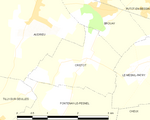Brouay War Cemetery
1944 establishments in FranceBritish military memorials and cemeteriesCanadian military memorials and cemeteriesCemeteries in Calvados (department)Commonwealth War Graves Commission cemeteries in France ... and 2 more
World War II cemeteries in FranceWorld War II memorials in France

Brouay War Cemetery is a Second World War cemetery of Commonwealth soldiers in France, located between Caen and Bayeux, Normandy. The cemetery contains 377 graves, of which 7 are unidentified. The cemetery is adjacent to the commune's graveyard.
Excerpt from the Wikipedia article Brouay War Cemetery (License: CC BY-SA 3.0, Authors, Images).Brouay War Cemetery
Rue des Grippes, Thue et Mue
Geographical coordinates (GPS) Address Nearby Places Show on map
Geographical coordinates (GPS)
| Latitude | Longitude |
|---|---|
| N 49.2148 ° | E -0.5619 ° |
Address
Rue des Grippes
14250 Thue et Mue
Normandy, France
Open on Google Maps











